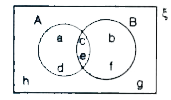Given A={x:x∈N and 3<x≤6} and B={x:x∈W and x<4}. Find :
(i) sets A and B in roster form:
(ii) A∪B, (ii) A∩B, (iii) A-B, (iv) B-A
The correct Answer is:(i) A = {4, 5, 6}, B = {0, 1, 2, 3} (ii) {0, 1, 2, 3, 4, 5, 6} (iii) ϕ, (iv) {4, 5, 6} (v) {0, 1, 2, 3}
To solve the problem step by step, we will first define the sets A and B in roster form, and then find their union, intersection, and differences.
Step 1: Define Set A in Roster Form
Set A is defined as:
A={x:x∈N and 3<x≤6}
The natural numbers (N) greater than 3 and less than or equal to 6 are:
- 4
- 5
- 6
Thus, in roster form:
A={4,5,6}
Step 2: Define Set B in Roster Form
Set B is defined as:
B={x:x∈W and x<4}
The whole numbers (W) less than 4 are:
- 0
- 1
- 2
- 3
Thus, in roster form:
B={0,1,2,3}
Step 3: Find A ∪ B (Union of A and B)
The union of two sets A and B includes all elements that are in A, in B, or in both:
A∪B={4,5,6}∪{0,1,2,3}
Combining the elements, we get:
A∪B={0,1,2,3,4,5,6}
Step 4: Find A ∩ B (Intersection of A and B)
The intersection of two sets A and B includes only the elements that are in both A and B:
A∩B={4,5,6}∩{0,1,2,3}
Since there are no common elements between A and B, we have:
A∩B=∅
Step 5: Find A - B (Difference of A and B)
The difference A - B includes the elements that are in A but not in B:
A−B={4,5,6}−{0,1,2,3}
Since none of the elements of A are in B, we have:
A−B={4,5,6}
Step 6: Find B - A (Difference of B and A)
The difference B - A includes the elements that are in B but not in A:
B−A={0,1,2,3}−{4,5,6}
Again, since none of the elements of B are in A, we have:
B−A={0,1,2,3}
Final Answers
1. A={4,5,6}
2. B={0,1,2,3}
3. A∪B={0,1,2,3,4,5,6}
4. A∩B=∅
5. A−B={4,5,6}
6. B−A={0,1,2,3}
Set A is defined as:
A={x:x∈N and 3<x≤6}
- 4
- 5
- 6
A={4,5,6}
Set B is defined as:
B={x:x∈W and x<4}
- 0
- 1
- 2
- 3
B={0,1,2,3}
The union of two sets A and B includes all elements that are in A, in B, or in both:
A∪B={4,5,6}∪{0,1,2,3}
A∪B={0,1,2,3,4,5,6}
The intersection of two sets A and B includes only the elements that are in both A and B:
A∩B={4,5,6}∩{0,1,2,3}
A∩B=∅
The difference A - B includes the elements that are in A but not in B:
A−B={4,5,6}−{0,1,2,3}
A−B={4,5,6}
The difference B - A includes the elements that are in B but not in A:
B−A={0,1,2,3}−{4,5,6}
B−A={0,1,2,3}
1. A={4,5,6}
2. B={0,1,2,3}
3. A∪B={0,1,2,3,4,5,6}
4. A∩B=∅
5. A−B={4,5,6}
6. B−A={0,1,2,3}
Topper's Solved these Questions
- BOOK - ICSECHAPTER - SETS EXERCISE - EXERCISE 6( E)11videos
SETS
- BOOK - ICSECHAPTER - SETS EXERCISE - EXERCISE 6( C)11videos
SETS
- BOOK - ICSECHAPTER - REPRESENTING 3-D IN 2 -DEXERCISE - EXCERSICE13videos
REPRESENTING 3-D IN 2 -D
- BOOK - ICSECHAPTER - SPECIAL TYPES OF QUADRILATERALSEXERCISE - EXERCISE22videos
SPECIAL TYPES OF QUADRILATERALS
Similar Questions
If P={x:x∈W and 4≤x≤8} and Q={x:x∈N and x<6}. Find :
(i) P∪Q and P∩Q
(ii) Is (P∪Q)⊃(P∩Q) ?View SolutionFrom the given diagram find:
(i) A∪B
(ii) A'∩B
(iii) A-B
(iv) B-A
(v) (A∪B)'
 View Solution
View SolutionIf A = {5, 6, 7, 8, 9}, B={x:3<x<8 and x∈W} and C={x:x≤5 and x∈N}. Find :
(i) A∪B and (A∪B)∪C
(ii) B∪C and A∪(B∪C)
(iii) A∩B and (A∩B)∩C
(iv) B∩C and A∩(B∩C)
Is (A∪B)∪C=A∪(B∪C)?
Is (A∩B)∩C)=A∩(B∩C)?View SolutionIf A={x∈R:0<x<4}andB={x∈R:1≤x≤7} then find AΔB.
View SolutionIf A and B are two sets such that A⊆B, then find
(i) A∪B
(ii) A∩B.View SolutionIf A={x∈W:5<x<10},B={3,4,5,6,7} and C={x=2n,n∈N and n≤4}. Find:
(i) A∩(B∪C), (ii) (B∪A)∩(B∪C)
(iii) B∪(A∩C), (iv) (A∩B)∪(A∩C)
Name the sets which are equal.View SolutionIf A = { x : x = 3n+2,n∈N,n≤6}
B = { x : xis an even number natural number 4,<x<15} and
C = { x: x = 3n , n∈N,n<8} then find
(i) A∪B
(ii) A∩B
(iii) A∩C (iv) B∩C
Also find whether the sets A and B : A and C, B and C are disjoint or overlapping sets .View SolutionLet A={x:x is a prime number less than 10} and B={x:x∈Nand0<x−2≤4} then A-B is
View SolutionGiven, universal set ={x:x∈N,10≤x≤35},A={x∈N:x≤16} and B={x:x>29}. Find: (i) A', (ii) B'
View SolutionLet A={x:x∈R,−1<x<1}, B={x:x∈R,x≤0orx≥2} and A∪B=R−D, then find set D
View Solution

